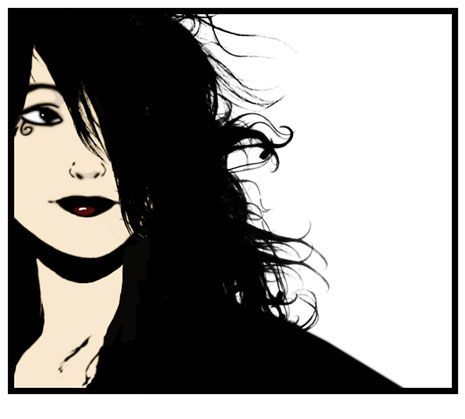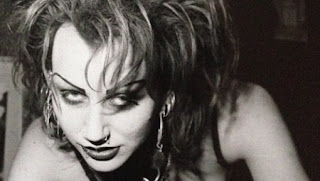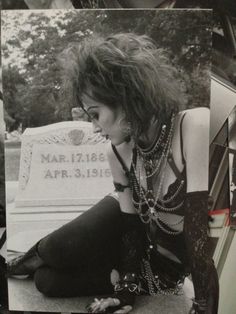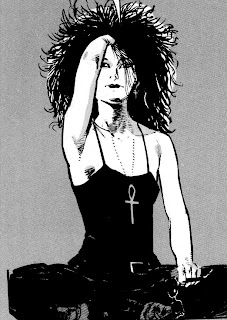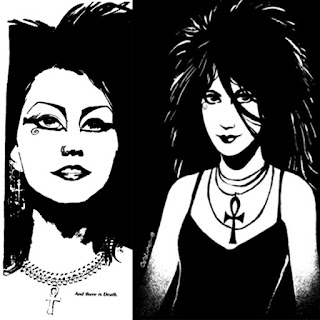Picture death personified. Maybe you imagine a skull-faced reaper with a cloak and scythe or a terrifying angel on his pale horse. Or maybe, if you’re of the right age and background, death is a perky goth girl with a penchant for Mary Poppins and an Eye of Horus spiral on her cheek.
This incarnation of Death, introduced in a 1989 issue of the DC/Vertigo comic The Sandman, may be the most beloved of popular culture’s psychopomps—mythical beings that guide the dead souls to the afterlife. Named the fifteenth greatest comic character by Empire Magazine in 2008 (ahead of Iron Man and Wonder Woman), she has graced posters and t-shirts. Even more than twenty years after she first chirped happily through the pages of issue #8, she inspires convention attendees to dress up in detailed recreations of her costumes.
Death (or rather, the woman who inspired her appearance) also happens to be a Salt Lake City native.
Meet Cinamon Hadley, the body-piercer and muse whose portrait was immortalized as the second eldest in a family of anthropomorphized forces, called The Endless, in Neil Gaiman’s cult-classic series. Extremely tall, extraordinarily thin, with bone-white skin, impeccable make-up and thin, black dreadlocks that fall well past her waist, she is an arresting sight. As we’re sitting down to talk, a passing cyclist slows down to exclaim, “I like your locks!” and earns a beaming smile from Hadley.
Despite most people’s assumptions, Hadley was never Gaiman’s inspiration for the character—neither was Tori Amos, who is sometimes credited as such, nor was Donna Ricci who, in an interview published in Bite Magazine, described in detail meeting with Gaiman for a photo shoot, but has since removed the claims from her website. Hadley has never met Gaiman, although they have exchanged emails. In fact, Death wasn’t even supposed to be a goth girl and Gaiman wasn’t actually responsible for creating Death’s signature look at all.
So how did Hadley end up inspiring Death?
Originally, writes Gaiman in The Sandman Companion, he imagined the character as looking like ‘60s singer Nico as she appeared on the cover of Chelsea Girl. But the comic’s artist, Mike Dringenberg, also a Salt Lake City resident at the time, had other ideas. Gaiman writes, “He sent me a drawing based on a woman he knew named Cinamon—the drawing that was later printed in Sandman 11—and I looked at it and had the immediate reaction of, ‘Wow. That’s really cool.’”
Hadley explains how she went from begging for spare change and living in the infamous ‘80s Salt Lake City flophouse called Kill Pigs to gracing the pages of a world-famous comic. “Mike Dringenberg was a good friend of mine,” says Hadley. “He told me that he wanted to use me for a model for a character in a comic book, but I didn’t think anything about it.” It wasn’t until years later, the conversation long forgotten, that she leafed through an issue at a friend’s apartment in Houston, Texas and found Dringenberg’s original drawing of her looking up from the pages and a personal thanks from the author for the use of her image.
“Hey, this is me!” she exclaimed, to the amazement of her friend.
She laughs now about the origin of an introductory image of Death sitting on some steps near a fountain. She says it was based on an image Dringenberg captured of her after she’d begged fifty cents to buy a hamburger and sat down on some steps to eat it, grinning in delight about her meal. In the comic, Death is grabbing the sides of her sunglasses, but it’s easy to imagine a hamburger in her hands instead.
It was, she says, a boost to her confidence and self-esteem. Asked if being Death has changed her life, she smiles and says it gives her a reason to meet people and has opened up social avenues. “People either want to meet me [because they admire the character],” Hadley says, “or they don’t … they think I’ll be stuck up.” She notes that even her girlfriend (now her fiancée) didn’t want to meet her at first. “She said, ‘I figured you were going to be so self-absorbed.’”
Like Death, Hadley says she is upbeat and perky, and like Death, she comes across as surprisingly down-to-earth despite her appearance. She makes it a point to stay positive, especially when she meets people who know her as “the model for Death,” or someone asks her to sign comics or merchandise. She says she wonders sometimes if Dringenberg used her just for her look, or if it was deeper, if he saw Death’s ironically happy attitude in her. “[Death is] strangely innocent in a way, and that is so me. I’ve always been an innocent person. My motto is ‘Happy, happy, joy, joy.’ I’ve just got to be happy. She even says ‘peachy keen,’ in one of the comics!”
Indeed, Death offered an effervescent contrast to her brother, Sandman’s titular Morpheus aka Dream, whose sad and sometimes angry persona was revealed in the comic through his black speech bubbles and dark expressions. In her first appearance in the story The Sound of Her Wings, Death takes Dream along on her sad route, escorting the souls of a newly departed SIDS baby, an electrocuted comedian and a young car-crash victim to the afterlife. However, despite her morbid job, she pronounces things “fantabulous” and, as Hadley mentions, “peachy keen,” and tries to cheer up her morose sibling.
Fans immediately fell in love with Death—as the letters to the editor showed—and her popularity quickly outstripped that of the rest of The Endless. In issue #21, a series of portraits and character studies of the siblings offers a few paragraphs about each and concludes with simply, “And there is Death.” Nothing else was needed—everyone already knew her.
While generally positive, being popularized as such a beloved character hasn’t always been a good experience. In addition to taking care to be nice to people who know her only as “Death,” Hadley occasionally has to clear up some rumors that get circulated on the Internet. In one case, a man claimed to have shared “a psychotically wonderful romance and an efficiency co-op apartment” with her before she ran off with a heroin dealer. It is telling that this man spelled her name wrong despite “loving her deliriously.” Hadley laughs in mock-horror about this now. “I was so angry!” she says of reading the bizarre blog post where this alternate history was revealed, to which she offered a scathing reply. Now she is kinder, although no less insistent that he was lying. “He was sweet, but kind of a sad soul. Maybe he was searching to be somebody ... He latched onto me because of the comic book.”
Some people have even theorized that Dringenberg was a hanger-on whose unhealthy and obsessive crush was a source of discomfort and disgust to her, but Hadley shakes her head about that, too. “We were really, really good friends. It makes it hard when you’re that close. I always got the feeling that there was a strong … maybe obsession? But I don’t know that it was unhealthy.” She says that she’d love to be in touch with Dringenberg, but has lost touch with him over the years.
Hadley has only recently returned to Salt Lake City, after spending close to 20 years away. She hitchhiked to Seattle to see her favorite band at the time, Skinny Puppy, and spent a few months there, before traveling to Houston to provide emotional support to her mother during her parents’ divorce. She spent some time living and working as a mime in New Orleans, with “bright yellow hair and long black fingernails” and lived in Texas’ liberal enclave, Austin, but eventually went back to Houston to open a body-piercing shop, even though she didn’t like the city very much. “It doesn’t have a very accepting environment of anything out of the norm,” she says.
She might still be in Houston if it wasn’t for The Ritz reunion in 2010. In the late ‘80s and early ‘90s, The Ritz Club was the preeminent dance club for Salt Lake City’s gothic, industrial and new wave scenesters. When a reunion weekend was planned, Hadley’s friend, industrial DJ Aaron Shea, decided that it would be no true reunion without her. He took up a collection to bring her back home for the weekend and her old friends gave generously.
Hadley says she didn’t expect to feel any emotions about the visit, but “it was the strangest thing. Getting ready to land, I looked out the window and I saw the mountains and I burst into tears. It felt like, ‘Wow, I’m home.’” That weekend made up her mind, she says. “The way the air felt and seeing everybody, I thought, ‘I’ve got to come home.’ I decided within a couple of days of being here that I was coming back.”
She hopes to get back into body piercing and is happy to find herself with a lifestyle that makes her happy, living life the way she wants to 20 years down the road. “I think it’s great that dreadlocks, tattoos and piercings are ‘normal,’” Hadley says, laughing. She has no regrets about her return. “I’m home and I can’t ever leave again! There’s so much more that goes on here,” she says. “The Dark Arts Festival and the bands that come here.”
Then there’s the snow. She loves the snow. “I was sad when it all melted this morning,” she says ruefully, but then she brightens up immediately and is the picture of the joyful woman who inspired an artist and changed the face of Death. All that’s missing is the spiral on her cheek.


